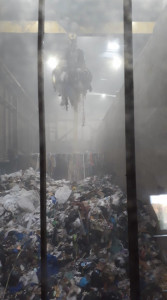At 3:45 p.m., a smouldering fire began in a raw-waste storage bunker at an incineration plant. At the time of the accident, the plant was on a scheduled shutdown to allow maintenance work on its two furnaces. The overhead crane technician saw the fire start. The bunker was sprayed with deluge guns and a fire-hose reel. As smoke continued to rise, the plant was evacuated at around 4:00 p.m. The waste was recovered using a grab crane. Firefighters set up two additional hoses. As a preventive measure, they sprayed the area and used a portable thermal imaging camera to look for hot spots. None were found. The firefighting operations ended at 8:00 p.m. The plant was monitored and the area was sprayed once an hour until 8:00 a.m. the following morning as a preventive measure.
The economic impact was small. Shutdowns and delays were required to allow maintenance.
As raw waste continued to be collected even while the furnaces were shut down, the bunker contained 3500 t of waste for a capacity of 3800 t. The bunker and shredders are separated by a curtain with a sheet metal portion that was being ground and welded to repair damage. Although this maintenance work had been authorised by a hot-work permit and a risk analysis (prevention plan) had been conducted, the operator suggested that it may have started the fire.
The operator implemented the following actions:
- installed thermal imaging cameras to monitor the bunkers (2019);
- changed the organisation of hot-work in the shredder/bunker area.
These organisational efforts paid off (pressurisation of the control room, removal of machinery parked in the reception hall, evacuation of personnel to the assembly point).




